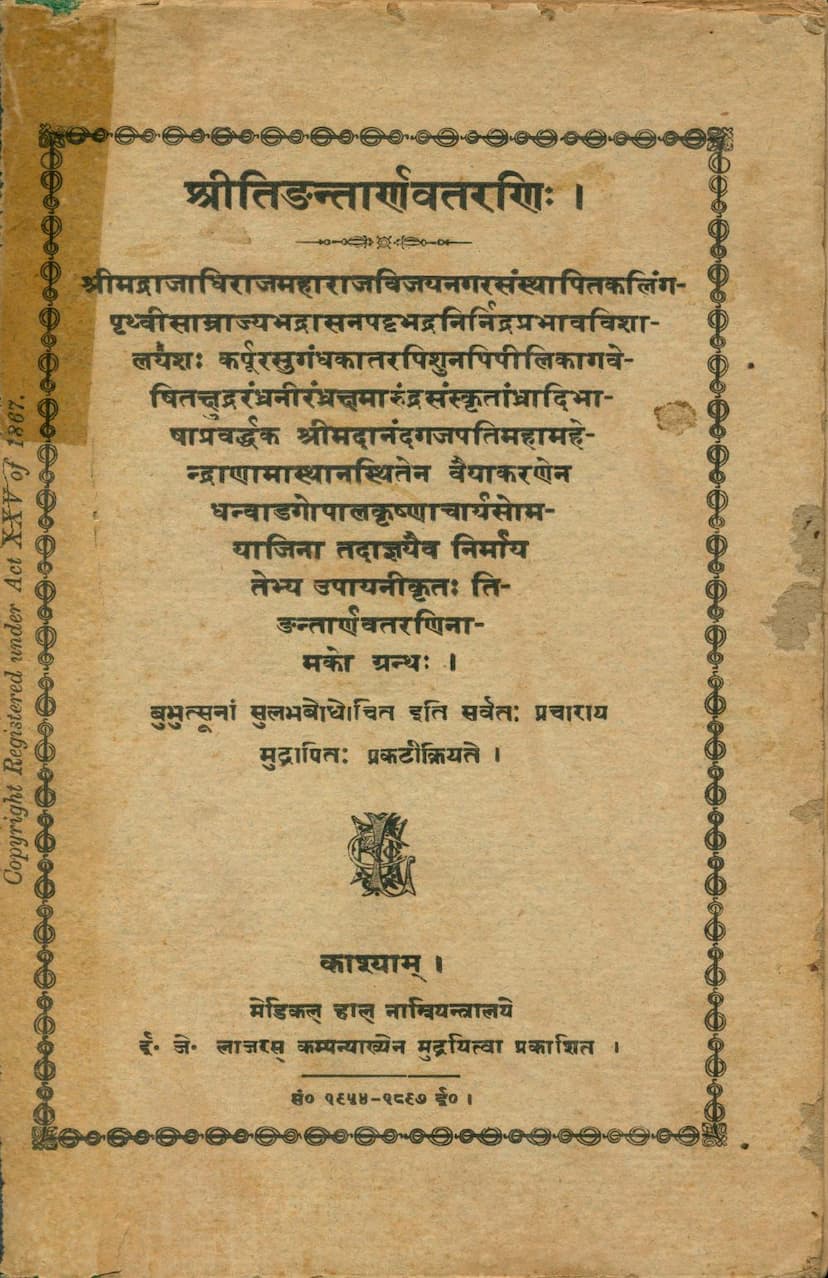Tidantarnavatarani
Added to library: September 2, 2025

Summary
Here is a comprehensive summary of the Jain text "Tidantarnavatarani" by Dhanvada Gopalkrishnacharya Somayaji, based on the provided pages:
Book Title: Tidantarnavatarani (or Tiñantārṇavataraṇi) Author: Dhanvada Gopalkrishnacharya Somayaji Publisher: E J Lazarus and Co Publication Year: 1891 (mentioned in the English title page), 1897 (mentioned in the Sanskrit title page)
Overall Purpose: The "Tidantarnavatarani" (meaning "The Ferry Boat on the Ocean of Verb Conjugations") is a Sanskrit grammar text focused on the conjugation of Sanskrit verbs. Its primary aim, as stated in the preface, is to simplify the understanding and practice of Sanskrit verb forms, making them accessible even to those who are not deeply learned in grammar. It serves as a guide to the complex world of verb roots (dhatus) and their various conjugations, particularly focusing on the "tinanta" or finite verb forms.
Key Features and Content:
-
Patronage and Dedication:
- The book was prepared under the special order and patronage of His Highness Sri Ananda Gajapati, Maharaja of Vizianagram.
- The author, Dhanvada Gopalakrishna Acharya Somayaji, was a grammarian at the court of the Maharaja.
- The text is presented as an offering (upāyanīkr̥taḥ) to the Maharaja, highlighting the significant royal support behind its creation.
-
Structure and Organization:
- The core of the book is a Dhatupatha ( धातुपाठ ), a systematic catalog of Sanskrit verb roots.
- The Dhatupatha is organized alphabetically by the initial letter of the Sanskrit verb root, starting with 'अ' (a) and proceeding through the Sanskrit alphabet.
- Each verb root is presented with its:
- Meaning (अर्थ): A concise explanation of the root's semantic function.
- Anunasika indication (अनुः): Indicating if it's an Anunasika ( nasalized sound ) root.
- Perapada/Atmanepada classification (परस्मैपदं / आत्मनेपदं / उभयपदं): Whether the root conjugates in the active voice (Parasmaipada), middle voice (Atmanepada), or both.
- The accompanying suffix (शप्, श्लु, श्यन्, श्नु, णिच्, नुः, etc.): These are crucial grammatical markers indicating the specific conjugation pattern or tense/mood formation associated with the root.
- Page Number: A reference to the page where the detailed conjugations or further information might be found (though the provided pages primarily show the catalog itself).
- The text includes an extensive Bhumika (भूमिका) or Preface, explaining the genesis of the work, the author's intention, and the process of its creation, including feedback from learned scholars.
- There are sections on Ladas (लडादि), which refer to the different verb moods and tenses in Sanskrit grammar (Lat, Lit, Lut, Let, Lot, Lan, Li, Lun, Lr̥n, Lin), outlining their usage and formation.
- The book also clarifies Padavyavastha (पदव्यवस्था), concerning the rules for Parasmaipada and Atmanepada conjugation, as well as the role of roots affected by augmentations (like
san,kyac,kyang, etc.).
-
Content of the Dhatupatha:
- The Dhatupatha is remarkably comprehensive, listing hundreds of verb roots.
- The entries are structured in a way that aids quick reference, allowing students to find a root based on its initial letter and then its subsequent conjugation markers.
- The initial pages provide a detailed breakdown of the verb roots based on their starting alphabets, such as:
- A (अ): A very large section, covering roots from 'अक' to 'अस्', with numerous sub-categories based on suffixes.
- Aa (आ): Roots starting with 'आ'.
- I (इ): Roots starting with 'इ'.
- Ii (ई): Roots starting with 'ई'.
- U (उ): Roots starting with 'उ'.
- Ū (ऊ): Roots starting with 'ऊ'.
- E (ए): Roots starting with 'ए'.
- O (ओ): Roots starting with 'ओ'.
- Ka (क): Roots starting with 'क', showing an extensive list.
- ...and so on, covering the entire Sanskrit alphabet.
-
Grammatical Principles:
- The book implicitly or explicitly follows the principles of Sanskrit grammar as codified by ancient grammarians like Panini, likely drawing from Pāṇinīya grammar and potentially other commentaries.
- The explanation of suffixes like
śap,ślu,śyan,śnu, andṇicis fundamental to understanding the structure of Sanskrit verbs.
-
Language and Presentation:
- The text is written in Sanskrit, using Devanagari script.
- The English title page indicates the intention to make Sanskrit verbs "easy."
- The publication details are provided in both Sanskrit and English, indicating a dual audience or a translation of some introductory material.
Significance: The "Tidantarnavatarani" is a valuable resource for students and scholars of Sanskrit grammar. Its systematic organization of verb roots, coupled with the indication of their meanings and conjugation patterns, makes it a practical tool for mastering Sanskrit verb conjugations, which are notoriously complex. The royal patronage underscores its perceived importance in the academic circles of late 19th-century India.
In essence, the book aims to be a comprehensive and user-friendly reference for Sanskrit verb conjugations, fulfilling its promise of making the "ocean of verb conjugations" navigable for its readers.